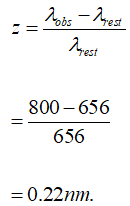Problem B.3: Mysterious Object Your research team analysis the light of a mysterious object in space. By using a spectrometer, you can observe the following spectrum of the object. The Ha line peak is clearly visible: 1.0 0.8 0.6 0.4 0.2 H 0.0 500 550 600 650 700 750 800 850 Wavelength [nm] (a) Mark the first four spectral lines of hydrogen (Ha, HB, Hy, H5) in the spectrum. (b) Determine the radial velocity and the direction of the object's movement. (c) Calculate the distance to the observed object. (d) What possible type of object is your team observing? Relative Flux [arb. unit]
Please help me in this. It's urgent.
![Problem B.3: Mysterious Object
Your research team analysis the light of a mysterious object in space. By using a spectrometer,
you can observe the following spectrum of the object. The Ha line peak is clearly visible:
1.0
0.8
0.6
0.4
0.2 H
0.0
500
550
600
650
700
750
800
850
Wavelength [nm]
(a) Mark the first four spectral lines of hydrogen (Ha, HB, Hy, H5) in the spectrum.
(b) Determine the radial velocity and the direction of the object's movement.
(c) Calculate the distance to the observed object.
(d) What possible type of object is your team observing?
Relative Flux [arb. unit]](/v2/_next/image?url=https%3A%2F%2Fcontent.bartleby.com%2Fqna-images%2Fquestion%2Fc8be6ca0-f5ba-4f53-8f85-9ba41d08eb5b%2Fe3cafea7-f400-46d0-a002-92c0efd05c9b%2Fxefs4p_processed.png&w=3840&q=75)
Doppler shift is the change in frequency or wavelength of a wave with respect to the observer. When an object is coming towards us, we can say that it is blue-shifted and when the object is moving away from us, we can say that the object is red-shifted. By analyzing the spectrum of a star, we can identify many elements present in that star. One of the main element is the hydrogen and the transitions of hydrogen atoms from various energy levels would provide specific series of notable lines in the visible spectrum. These wavelengths are shifted when the object is doppler shifter. When the object is moving away from us, the wavelength of the wave is shifted to higher frequency or we can say that it is red-shifted.
The velocity of the object can be determined using this spectrum. The velocity in the radial direction of an object moving away from us is equal to the product of velocity of light and the redshift.
That is,

The object velocity is calculated using the formula given below,

The distance towards the observed object is determined using the equation,

where H0 is called the Hubble's constant, which is approximately around 75km/s/Mpc.
(a) The rest wavelengths of H-alpha, H-beta, H-gamma and H-delta lines are given below;

(b) Consider the rest and observed wavelengths of H-alpha line.
Rest wavelength of H-alpha line=656 nm
Observed wavelength of H-alpha line in the spectrum=800 nm
Therefore, the redshift is calculated as,

Now, the radial velocity is calculated using equation (1),

That is, the object is moving away from us with a velocity of 66000 Km/s.
Step by step
Solved in 6 steps with 11 images
